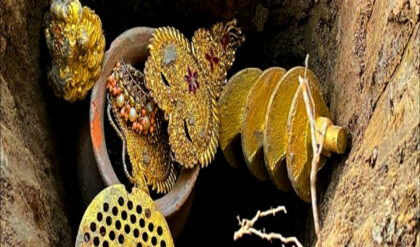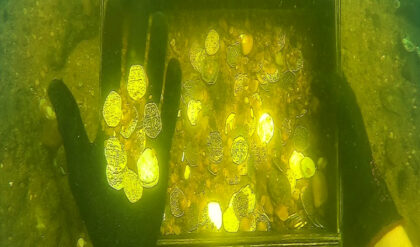A Georgia man came across a snake eating another larger snake while he was walking to pick up his mail.
Eighty-two-year-old Haddock resident Tom Slagle saw a kingsnake, a type of constrictor, devouring a venomous rattlesnake. Slagle managed to capture images of the event.
In the video, you can see the bottom half of the rattlesnake sticking out of the kingsnake’s mouth. The kingsnake continues to move its jaws around the rattlesnake’s body, swallowing it whole.
The video was reposted on Facebook by the Georgia Department of Natural Resources (DNR), with the title: “Kingsnake vs. Rattlesnake: It’s a snake-eating world.”

A DNR spokesperson told Newsweek that a kingsnake’s diet typically consists of rabbits, rodents, amphibians, turtle eggs, lizards and other snakes; It has even been observed to eat members of its own species.
“These constrictors are famous for their ability to defeat and eat venomous snakes, such as the rattlesnake seen consumed in the video,” the spokesperson said.
Kingsnakes are non-venomous and kill their prey by constriction. They are capable of capturing poisonous species by hitting and grabbing the prey by the head. The snake will then wrap itself around its prey and contract, before swallowing it whole and head-first.
King snakes are resistant to poisons that would kill a human. The venom of copperheads, cottonmouths, and rattlesnakes does not disturb the species. They may wag their tails and bite if provoked, but are generally relatively tame species and are sometimes kept as pets.
The rattlesnake that is consumed appears to be thicker than the real snake.
The Georgia DNR explained what happens in this situation in their Facebook post: “If the snake being eaten is longer than the real snake, it will bend before being swallowed.”
The video has accumulated hundreds of comments. Social media user Michelle Willet Keller wrote: “I wanted to watch him finish this meal and see how well he moved afterwards; “It looks like a HUGE meal!”
Others commented that the rattlesnake itself appeared to have recently finished a large meal, due to its large girth. Ashley Brock said: “And that’s exactly why you don’t kill the good snakes!! Thanks for sharing. That is incredible”.
Rattlesnakes may occasionally slither onto properties in search of food and shelter and are sometimes considered a nuisance. Although they normally only bite when provoked, this can inevitably cause conflict. Their stings are rarely fatal, but require immediate medical attention.
Kingsnakes reach a maximum length of about 6 feet. On average, females grow 4 to 4.5 feet, while males typically grow 3 to 3.5 feet. Timber rattlesnakes reach similar lengths. These venomous snakes can reach a maximum length of 7 feet long.
Snake season in Georgia is in full swing, with snakes beginning to become more active in the warmer spring and summer months.
Newsweek is committed to challenging conventional wisdom and finding connections in the search for common ground.
Newsweek is committed to challenging conventional wisdom and finding connections in the search for common ground.





